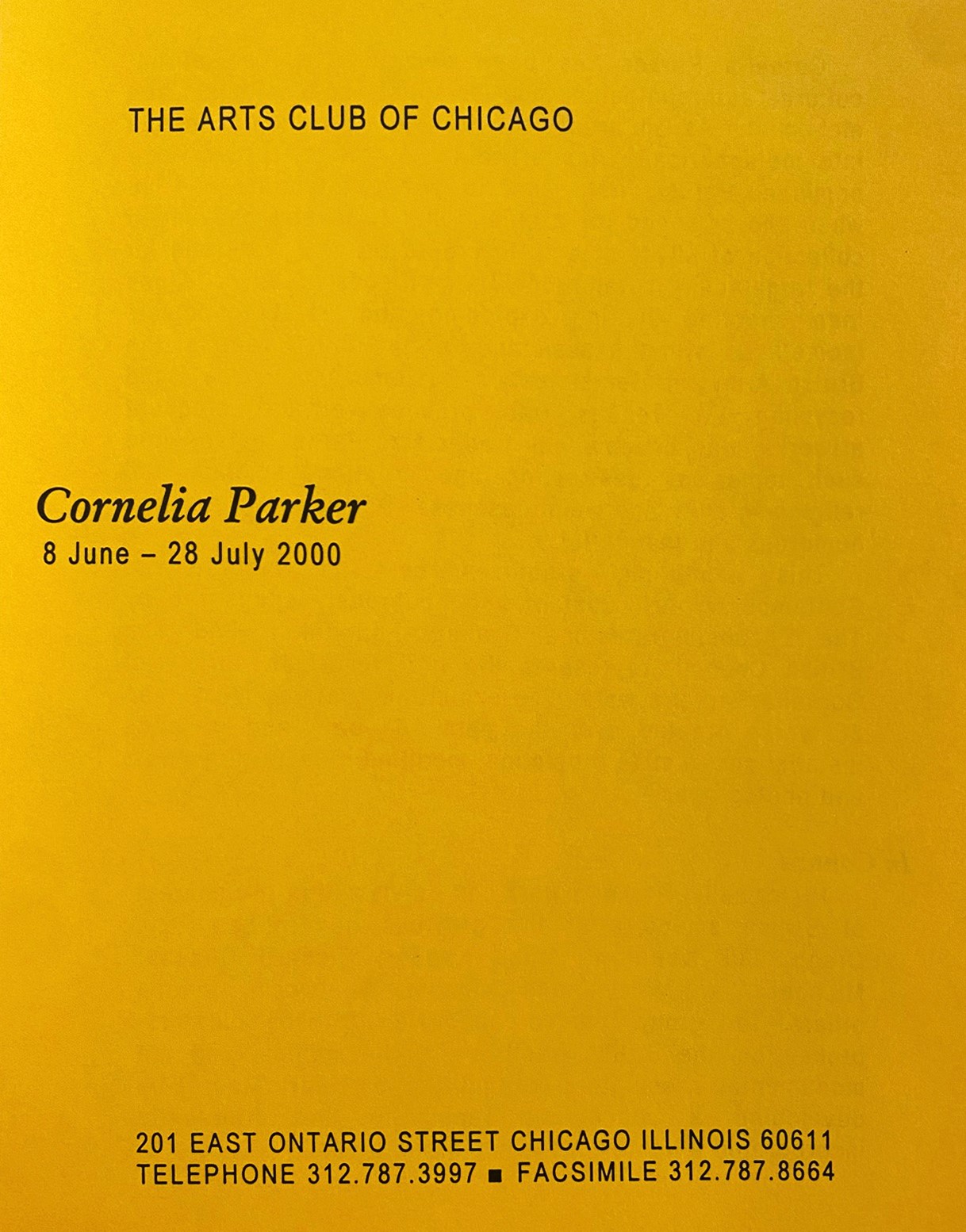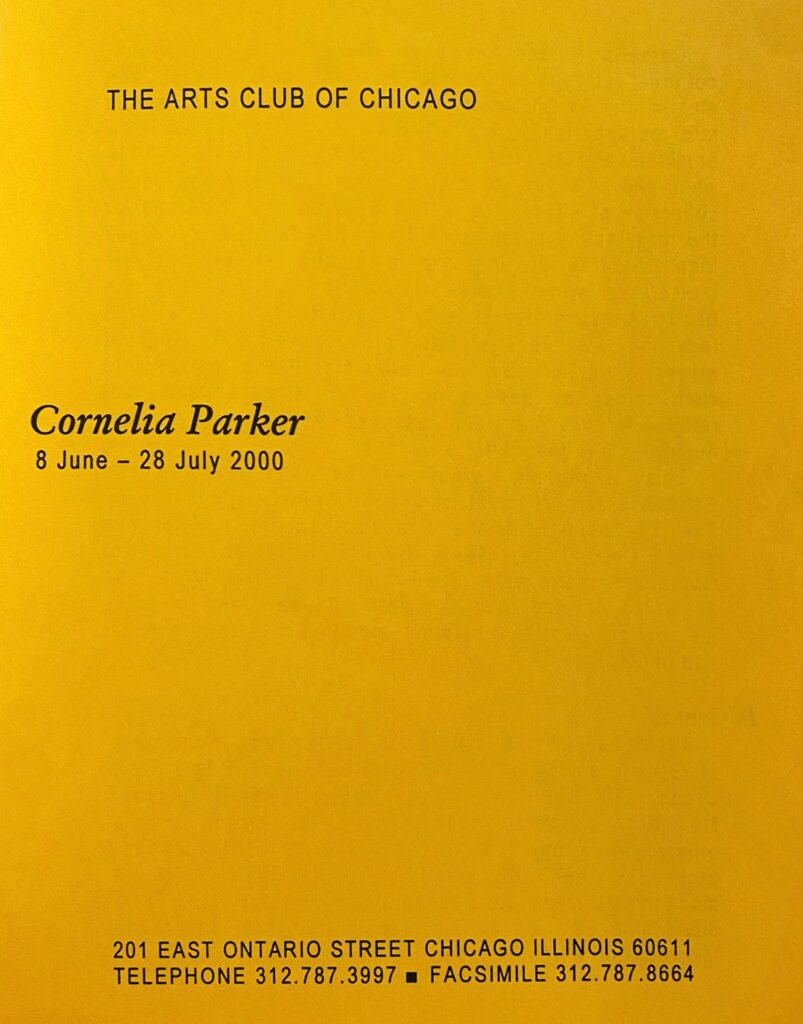Cornelia Parker


Past exhibition
Cornelia Parker
About the Exhibition
The Arts Club of Chicago is pleased to announce the opening of a Cornelia Parker exhibition on Thursday, June 8. The exhibition, which will travel to The Arts Club from the Institute of Contemporary Art, Boston, will feature installations, photographs, works on paper, and sculpture. It will run through July 21. The press is invited to the members-only opening tea on Thursday, June 8, from 4:00 p.m.–6:00 p.m.
Historically, Parker’s work can be viewed in the context of British sculptors of the previous generation, the so-called New British Sculptors: Tony Cragg, Bill Woodrow, Anish Kapoor, Richard Deacon, Michael Craig-Martin, and Richard Wentworth, among others. The group broke from the British traditions of the sublime and the monumental in sculpture (exemplified in particular by Henry Moore) by developing a conceptual sensibility that frequently incorporated a lighter, more humorous touch. The combined use of everyday found objects and conceptual titles allowed these artists to investigate a broad range of political and social references that had been largely ignored by post-war British artists. The visual and the verbal established a mutually informing but often intentionally contradictory relationship in their work.
Like these sculptors, Parker’s early work was motivated by the desire to break apart from the monumental. Both objects (sculptures or monuments) and concepts (religion, the institution of marriage) came under her wry wrecking ball. The question of transformation—from vast to minute, ethereal to worldly, spectacular to mundane—has continued to be a theme in her work that has developed more recently into a complex process comparable to the religious notion of transubstantiation. For instance, the title of an early work, Thirty Pieces of Silver, 1988–89, prepares the viewer for a story of betrayal of almost biblical proportions. For this large installation, Parker amassed a vast collection of abandoned silver commemorative cups, musical instruments, bowls, candlesticks, etc., laid them on a road, and had them crushed by a steamroller. The smashed items were then hung from the ceiling at shin height in various groupings. “Silver is commemorative,” explains Parker, “the objects are landmarks in people’s lives. I wanted to change their meaning, their visibility, their worth, that is why I flattened them, consigning them all to the same fate.”
Other large-scale suspended pieces include A Side of England, 1999 (not exhibited), a piece made of chalk from a cliff fall at Beachy Head at the south coast of England (a notorious suicide spot), and Hanging Fire (Suspected Arson), 1999–2000, a work made from the burst remains of a questionable fire. These later works constitute a substantial change in her approach to developing narrative in her work. While Thirty Pieces of Silver required Parker’s agency in the series of events that resulted in the transformation of materials, for A Side of England and Hanging Fire the primary agent in the act of transformation is something or someone other than Parker.
In comparison to her large, suspended installations, Parker’s smaller works are like tightly constructed poems in which every word has been chosen for optimum effect. Her Embryo Firearms, 1995, and Embryo Money, 1996, which were made with the participation of Colt Firearms and the Royal Mint, respectively, investigate the power of transformation. For these works, Parker displays the objects in their earliest stages of production: the ten pence pieces are blank metal discs and the guns are simple recognizable shapes with just the beginning of a barrel and trigger. At what point, Parker asks, is the power of money and guns imprinted, instilled, or conveyed in these otherwise innocent lumps of metal?
Parker’s fascination with comparing the miniature and gigantic appears in a series of measured works that involve drawn silver and gold. Measuring Niagara with a Teaspoon, 1997, is precisely that: a Georgian silver teaspoon melted down and drawn out to the height of the Falls. Her Wedding Ring Drawing (Circumference of a Living Room), 1996, a curling mass of twisting gold thread, is more ambiguous and represents an attempt to quantify or measure the boundaries or limits of domesticity using the metaphorical space of a living room.
Parker’s photographic works have developed out of her interest in the potential of specific materials, as well as her notion of an “avoided object” (not the object that is presented, but that which is not shown). In Collected Death of Images, 1996, Parker presents the silver particles left over from the process of “fixing” an image with photographic chemicals, an act that suggest that the silvers of silver contain lost images now forever trapped. In a series of photographs, all titled Avoided Object, 1999, Parker took pictures of clouds, but the clouds themselves are not the “focus” of the work, but rather function as a not-so-innocent springboard for the metaphorical or conceptual content. Under each title Parker notes, “photograph of the sky above the Imperial War Museum [London] taken with the camera that belonged to Höess, commandant of Auschwitz.”
The Cornelia Parker exhibition is organized by The Institute of Contemporary Art, Boston. Cornelia Parker is generously sponsored by The Elizabeth Firestone Graham Foundation and The British Council.
An accompanying full color 80-page catalogue, the first book on Parker’s work published in the United States, will be available for purchase. The catalogue features an essay by Curator Jessica Morgan and an interview with Parker by Bruce Ferguson, Dean of the School of Visual Arts at Columbia University.
About the Artist
Cornelia Parker has received solo exhibitions at London’s Serpentine Gallery and participated in a residency at ArtPace in San Antonio, Texas. Her work has been included in numerous international exhibitions including the Saõ Paulo Biennial and solo and group exhibitions in Vienna, Berlin, and Paris. Her blown-up garden shed, Colder Darker Matter: An Exploded View, is currently on view in “Between Cinema and a Hard Place,” at the Tate Modern, London.
A former Turner Prize nominee, Cornelia Parker’s work includes installations, slide projections, sculptures and photograms, all of which contain a surprising conceptual twist. Through a combination of careful presentation and research, Parker reveals a multitude of associations in her work that are at once humorous and thoughtful. Parker delves into such topics as destruction and creation, science and religion, yet her work remains unconstrained by heavy-handed theorizing. She melts, steamrolls, stretches, and explodes her materials to create works of both elegance and imagination matched only by their incisive wit.